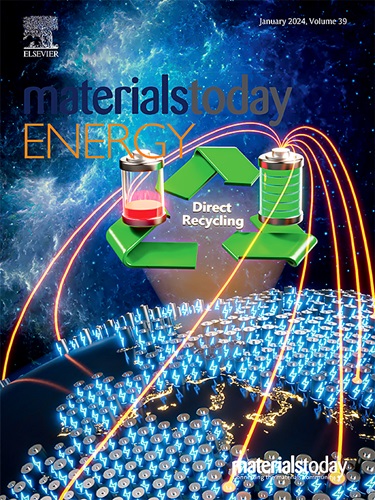A bioinspired hierarchical gradient structure to maximize resilience and enhanced cooling performance in polymeric radiative cooling coatings
IF 8.6
2区 材料科学
Q1 CHEMISTRY, PHYSICAL
引用次数: 0
Abstract
Despite the extensive advancements in recent years, polymeric daytime radiative cooling (PDRC) coatings face certain challenges, encompassing restricted spectral performance, susceptibility to aging, poor mechanical strength, and so forth. Herein, we proposed a facile biomimetic 500 μm thick PDRC coating, featuring a gradient distribution of pore sizes throughout the cross-section. The proposed functional structure demonstrates spectral characteristics of a near-ideal broadband emitter by attaining over 0.95 emissivity in the main atmospheric window and 0.99 reflectance in the visible spectrum. During the outdoor experiment, it achieved an 8.5 °C subambient temperature drop along with a cooling power of ∼106 W/m at the solar irradiance of ∼800 W/m and ∼650 W/m, respectively. Experimental findings highlight that the bioinspired design results in a tensile strength of ∼9 MPa along with a tensile strain of over 200%, which is more than twice that of non-gradient porous PDRC coatings. In addition, it offers tunable surface contact angle and manifests its resilience in anti-ultraviolet and water resistance tests. Furthermore, a building energy model reveals a decrease in cooling load of between 34 and 119 kWh/(m.year), establishing its real-world application under broader climatic regions.生物启发的分层梯度结构可最大限度地提高聚合物辐射冷却涂层的弹性和冷却性能
尽管近年来聚合物日间辐射冷却(PDRC)涂层取得了长足的进步,但仍面临着一些挑战,包括光谱性能受限、易老化、机械强度差等。在此,我们提出了一种厚度为 500 μm 的简易仿生物 PDRC 涂层,其特点是整个横截面上的孔径呈梯度分布。所提出的功能结构在主要大气窗口中的发射率超过 0.95,在可见光谱中的反射率达到 0.99,显示出接近理想宽带发射器的光谱特性。在室外实验中,当太阳辐照度分别为 800 瓦/米和 650 瓦/米时,它实现了 8.5 °C的亚环境温度下降,制冷功率达到 106 瓦/米。实验结果表明,受生物启发的设计使拉伸强度达到 9 兆帕,拉伸应变超过 200%,是非梯度多孔 PDRC 涂层的两倍多。此外,它还具有可调的表面接触角,并在抗紫外线和防水测试中表现出良好的弹性。此外,建筑能耗模型显示,该涂层可减少 34 至 119 kWh/(m.年)的制冷负荷,从而确定了其在更广泛气候条件下的实际应用。
本文章由计算机程序翻译,如有差异,请以英文原文为准。
求助全文
约1分钟内获得全文
求助全文
来源期刊

Materials Today Energy
Materials Science-Materials Science (miscellaneous)
CiteScore
15.10
自引率
7.50%
发文量
291
审稿时长
15 days
期刊介绍:
Materials Today Energy is a multi-disciplinary, rapid-publication journal focused on all aspects of materials for energy.
Materials Today Energy provides a forum for the discussion of high quality research that is helping define the inclusive, growing field of energy materials.
Part of the Materials Today family, Materials Today Energy offers authors rigorous peer review, rapid decisions, and high visibility. The editors welcome comprehensive articles, short communications and reviews on both theoretical and experimental work in relation to energy harvesting, conversion, storage and distribution, on topics including but not limited to:
-Solar energy conversion
-Hydrogen generation
-Photocatalysis
-Thermoelectric materials and devices
-Materials for nuclear energy applications
-Materials for Energy Storage
-Environment protection
-Sustainable and green materials
 求助内容:
求助内容: 应助结果提醒方式:
应助结果提醒方式:


